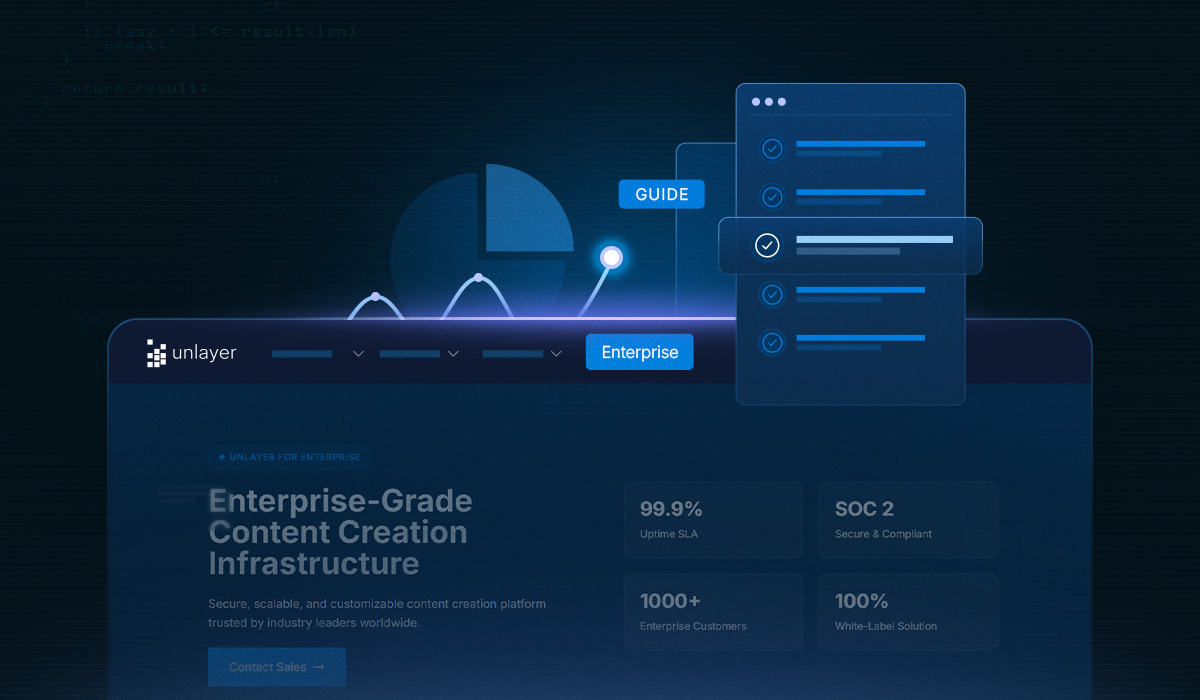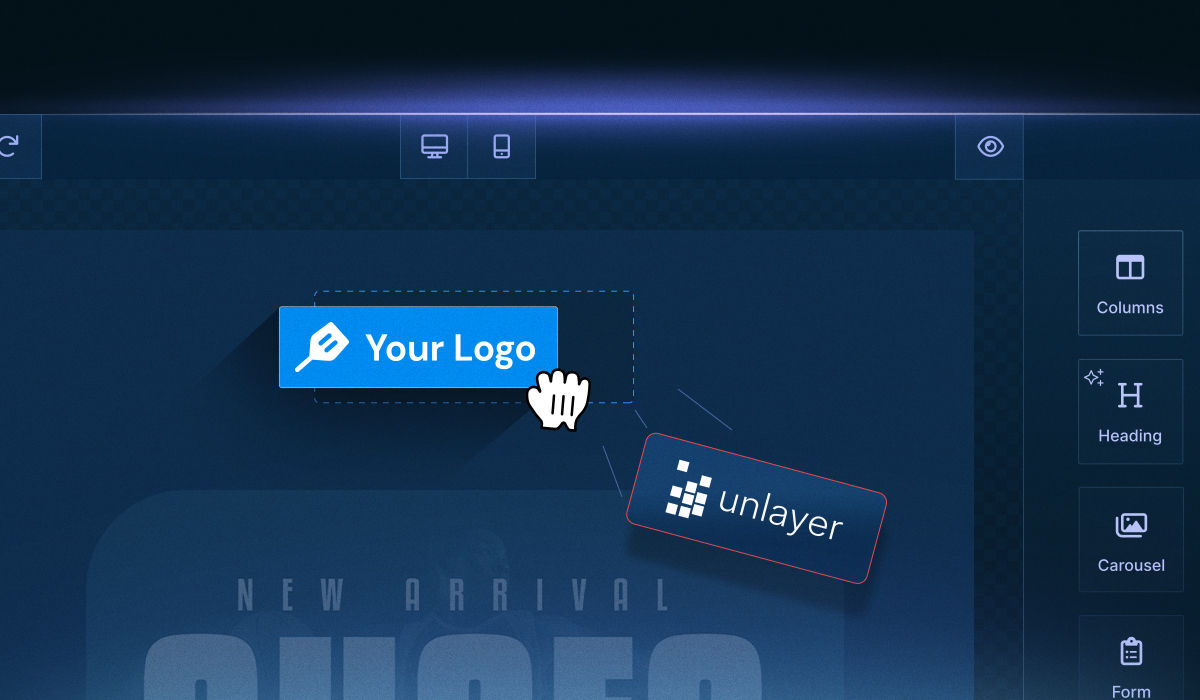Looking to embed content creation into your SaaS product without building everything from scratch? This blog breaks down the key decisions and tools involved in integrating powerful, user-friendly editors directly into your platform.
The main takeaways are:
Embed vs build: Know when to embed a content editor instead of developing a custom one, based on speed, resources, and maintenance.
What features matter: Learn what to evaluate in embeddable tools by white-label control, framework compatibility, export options, security standards, and SDK support.
Tool comparison: Explore five top embeddable content creation tools like Unlayer, Beefree SDK, Stripo Plugin, Builder.io, and Topol.io.
Unlayer’s advantage: See how Unlayer gives your dev team full control through SDKs, custom blocks, magic images, smart text, and white-labeled UI, ready to deploy within minutes.
What Are Embeddable Content Creation Tools?
Unlike standalone design platforms, embeddable content creation tools are built to live inside your product. They’re not just functional but framework-aware, developer-controlled, and user-facing.
They typically offer JavaScript SDKs, APIs, and plugins for frameworks like React, Angular, and Vue, making it easy to embed them directly into your product.
These editors manage everything from rendering and content export to backend logic and UI behavior, so your team doesn’t have to build or maintain any of it.
You simply embed the editor, align it with your branding, and take advantage of advanced customization options to tailor the experience to your users.
For teams already investing in no-code solutions, embeddable editors offer a faster way to deliver content capabilities, without adding long dev cycles to your roadmap.
Where they’re used:
CRM platforms use embedded editors to let users design and send emails directly from the host application.
LMS or HR platforms use them for creating onboarding documents or training content.
Client portals use embedded editors to enable users to build branded landing pages.
Marketing automation platforms use them to create content blocks and email templates for marketing campaigns.
Also Read: What Are Embeddable Editors & Why Do SaaS Platforms Need Them?
Next, let’s break down how embeddable tools compare to fully custom-built solutions.
Embeddable vs Custom-Built Content Tools
Custom tools give you full control, but that control comes at a cost. Embeddable content tools offer a faster, lower-risk path to delivering the same design functionality without reinventing the wheel.
How do embeddable tools actually stack up against building from scratch? The table below breaks it down across time, control, cost, and long-term ownership:
Criteria | Embeddable Content Tools | Custom-Built Tools |
Time to Market | Launch in weeks via SDK/API integration | 6–12 months for MVP |
Development Effort | Minimal; pre-built UI, logic, and backend included | High; full frontend + backend must be developed |
Branding & Customization | White-label, advanced customization options, custom blocks, and custom tools | Fully flexible, but requires significant dev resources |
Security & Compliance | SOC 2, GDPR, RBAC, audit logs (vendor-managed) | Must be built and maintained in-house |
Performance & Scale | Optimized for billions of requests | Depends on the internal team capacity |
Maintenance & Updates | Handled by vendor | Requires ongoing engineering effort |
Support & Documentation | Included with integration | Must be written and maintained internally |
Best For | Teams needing content creation fast and securely | Teams with long timelines and niche UI needs |
In most SaaS environments, especially when content creation isn’t your core product, embeddable tools outperform custom builds in speed, cost, and operational simplicity.
When to Use Embeddable Content Creation Tools
If embeddable tools offer customizability and speed, the next question is when they make the most sense. You don’t need to replace every UI component in your platform, but when content creation becomes a core part of your user experience, building from scratch starts to break down.
You should consider using an embeddable content tool when:
Content creation is part of your product flow: Your users need to design emails, landing pages, popups, or documents, and expect the same drag-and-drop experience they’d get from standalone tools.
Your roadmap can’t support long build cycles: Delivering a reliable, responsive editor isn’t a small sprint. If your team is focused on core product features, embedding can eliminate months of distraction.
You want design flexibility without compromising security: Embeddable tools like Unlayer offer a white-label solution, with robust features like custom blocks, custom tools, user permissions, SOC 2 compliance, and role-based access.
You’re serving non-technical users at scale: If your platform is used by marketers, sales teams, HR admins, public-facing platforms, or educators, intuitive design tools are no longer optional; they’re expected.
You need to deliver a branded experience inside your product: Rather than linking users to external tools, embeddable editors live inside your platform. You control the styling, the UX, and the data flow.
If you’ve decided embedding is the right choice, the next step is picking the right tool. Not all embeddable editors are built the same, so what should you look for?
What Elements to Look for in Embeddable Content Creation Tools
Choosing the right embeddable tool comes down to more than UI. You’re embedding a mission-critical layer into your product, so the tool needs to meet developer, security, and business expectations.
Here are the core factors to evaluate:

1. Developer-first architecture
Look for tools that offer SDKs and plugins for modern JavaScript frameworks (React, Angular, Vue), clear documentation with examples, and full API coverage. Integration time should be measured in days, not quarters.
2. Customizability
A strong embeddable tool behaves like a custom tool. You should be able to override the UI, inject custom blocks, define permissions, and style everything to match your brand.
3. Security and compliance
SOC 2 Type II, GDPR readiness, role-based access, and audit logs are non-negotiable for enterprise adoption. Tools that lack these will bottleneck sales and procurement.
4. Scalability
Check whether the platform handles high-volume API requests, concurrent users, and large teams. Built-in caching, optimized rendering, and battle-tested infrastructure matter when your editor becomes core UX.
5. Maintenance ownership
The vendor should own updates, bug fixes, and versioning. Your team shouldn't be spending time patching layout engines or updating export logic every release cycle.
6. Content output flexibility
Look for support for HTML, JSON, or custom output formats, especially if you need to plug the content into downstream workflows like email delivery, CMS publishing, or PDF generation.
7. Integration control
Tools should support webhooks, user management APIs, export endpoints, and advanced options like on-premise hosting or granular sandbox environments for enterprise use.
Top 5 Embedded Content Tools for SaaS Teams
The market for embeddable content tools has grown fast, with dozens of options now offering SDKs and white-label builders for product teams. However, not all are designed to scale, support enterprise security, or fit modern development stacks.
Below are the top tools used by SaaS platforms, CRMs, and marketing solutions to integrate on-brand, no-code design capabilities directly into their products.
Tool Name | Content Types | Branding & Customization | Free Plan or Trial |
1. Unlayer | Email, Page, Popup, Document | Fully white-label, SDK + custom blocks | Free plan + 14-day trial |
2. Beefree SDK | Email, Landing Pages | Custom blocks, styling overrides | Free plan available |
3. Stripo Plugin | Email (AMP supported) | White-label, modular design system | Free plan available |
4. Builder.io | Landing Pages | Visual override, Figma import, reusable components | Free plan available |
5. Topol Plugin | Custom styling, branding, and localization | 60-day free trial |
1. Unlayer

Unlayer offers a 4-in-1 embeddable builder suite that includes Email, Page, Popup, and Document editor. Delivered via APIs and SDKs, each builder is fully customizable, white-label ready, and designed to integrate directly into SaaS platforms with minimal setup.
Whether you need an embedded email builder, a customizable landing page builder, or full document and popup editing, Unlayer covers it all.
By embedding Unlayer, you can reduce development time while giving end-users an intuitive, no-code design experience inside the product they already use.
Key features
4-in-1 builder suite: email, page, popup, document
Intuitive drag-and-drop interface
Responsive email/landing page designs
Real-time preview mode for mobile, tablet, and desktop
Advanced customization options like appearance, editor behavior, and content settings
Framework agnostic: Works best with Angular, React, Vue, Next.js, and Vanilla JS
White-label UI with custom tools, custom blocks, and workflows
API-first architecture for retrieving, loading, and saving designs
Enterprise-grade security: SOC 2 Type II certified
Scalable infrastructure proven across high-volume SaaS platforms
Pricing
Unlayer offers a forever-free plan for evaluation. Paid plans include Launch ($225/month), Scale ($675/month), and Optimize ($1800/month), along with customized enterprise plans, all billed annually. Each offers a 14-day free trial.
Try Unlayer for free to embed a secure, branded content builder that fits your stack from day one.
Best for
B2B SaaS companies, CRMs, marketing platforms, and enterprise portals that need secure, branded content creation tools without building from scratch.
2. Beefree SDK

Beefree SDK offers an embeddable email editor with drag-and-drop functionality, customizable blocks, and integration-ready HTML output. It also includes optional modules for landing pages, popups, a file manager, and content services that can be activated as needed.
Teams use it to bring no-code content creation into their apps without starting from scratch. With detailed API documentation, sample code, and developer-first resources, it’s a strong fit for SaaS platforms that need email design capabilities built for scaling and maintainability.
Key features
Three seamless builders in one: emails, landing pages, and popups
Template catalog API for dynamic template loading and management
Multi-language UI and content support for localized email creation
Real-time collaboration with co-editing and inline commenting
Brand style enforcement to ensure the layout and theme consistency
Pricing
Beefree SDK offers a Free tier with usage-based fees. Paid plans include Essentials ($350/month), Core ($1,000/month), Superpowers ($2,500/month), and Enterprise ($5,000/month), with additional usage fees depending on implementation needs.
Best for
SaaS platforms, marketing tools, and CRMs looking to add a flexible email and content builder with minimal integration effort.
3. Stripo Plugin

If you need to add campaign-ready email creation inside your CRM, the Stripo Plugin delivers a block-based editor with AMP support, smart elements, and full HTML export.
Stripo hosts all server components, so teams can embed the editor via JavaScript without building backend services.
It’s a practical fit for marketing platforms, e-commerce SaaS, and email automation tools that want to offer reusable templates and interactive design elements, like timers, banners, or product carousels, without extending development cycles.
Key features
Custom module library for reusable content blocks
AMP component support for timers, banners, and product carousels
External image libraries, such as Pexels and IconFinder, for in-editor asset selection
Email previews across major clients and devices
Dynamic content support for building personalized campaigns
Pricing
Stripo offers a Free plan with no credit card required. Paid plans include Basic ($20/month), Medium ($45/month), and Pro ($95/month), with increasing limits on projects, exports, and roles depending on team size and use case.
Best for
Platforms that need to offer interactive, template-driven email creation using AMP components, custom modules, and rich design features with minimal backend work.
4. Builder.io

Builder.io offers a visual content editor that embeds into apps built with React, Vue, Angular, Next.js, or plain HTML. It integrates with composable frontends and headless architectures, giving teams layout control without rewriting code.
This setup is ideal for product teams managing landing pages, internal dashboards, or branded user portals. It helps developers maintain full control of components while enabling non-technical teammates to handle layout edits, A/B testing, and visually targeted content.
Key features
Full-page visual builder with drag-and-drop UI and no-code controls
Real-time editing of live production pages without deploy cycles
Import design components directly from Figma for visual reuse
Reusable components from your internal design system with override control
Version history, rollback tools, and safe previewing before publishing
Pricing
Builder.io offers two plan types: Publish and Fusion. Both include Free and Pro tiers. The Publish Pro plan starts at $39/month, while the Fusion Pro plan starts at $24/month. Enterprise options are also available.
Best for
Product teams building composable frontends who need to offer live page editing, A/B testing, and personalization without giving up developer control.
5. Topol.io Plugin

Topol.io Plugin gives developers a fast way to embed an HTML email editor using a hosted JavaScript plugin. It requires no backend configuration and supports full UI customization, block management, and localization.
This setup is ideal for product teams building CRMs, martech tools, or client platforms that need a responsive email builder with brand control without spending months on frontend development.
Key features
Custom block support with full brand styling control
Clean HTML export for use with any email delivery system
Localization-ready interface for multi-language platforms
Responsive design output optimized for mobile and desktop
Automatic updates handled by Topol’s infrastructure
Pricing
Topol Plugin is available in three tiers: Plugin for Startup ($70/month), Plugin Expansion ($140/month), and Plugin for Business ($300/month), each with a 60-day free trial.
Best for
Platforms that need a responsive, embeddable email editor with minimal setup, full branding control, and HTML output for integration with existing delivery systems.
Some tools are optimized for email workflows, others for page or document creation. Some prioritize fast setup with hosted plugins, while others give you deeper control through SDKs. Choosing the right tool means weighing your product’s scope, branding requirements, and the flexibility your team needs to own the experience.
Conclusion
Building an in-app content editor is rarely the best use of your development time. With embeddable content creation tools, you can offload layout logic, rendering, and responsiveness, while still owning the branding, access control, and integration flow.
Unlayer provides all of that in one SDK suite, covering email, page, popup, and document builders. It's white-label, secure, fast to deploy, and already trusted by 1,000+ SaaS teams.
Want to see how Unlayer fits into your product? Contact our sales team for a personalized walkthrough.
FAQs About Embeddable Content Creation Tools
Still have questions? Let’s address the most frequent ones.
1. Can I embed an email builder in a React, Angular, or Vue app?
Yes, most embeddable content creation tools like Unlayer offer JavaScript SDKs or Angular/React/Vue plugins that let you integrate a drag‑and‑drop email builder directly in your app with minimal setup and styling control.
2. Do embeddable editors support no-code workflows for non-technical users?
Absolutely. Many builders are marketed as no-code solutions, allowing admins or marketers to design content visually without programming. They typically include drag-and-drop interfaces, custom styling, and export-ready formats.
3. What are some alternatives to custom-built content editors?
Embeddable content creation tools like Unlayer offer pre-built, customizable editors that save development time and improve time to market compared to building and maintaining a custom solution.
4. How do I choose the right embeddable content editor for my product?
Start by narrowing in on the core content types your users need to create, such as emails, landing pages, pop-ups, or documents. Then, assess each tool using criteria like:
Integration method: Does it offer an SDK, plugin, or API? How easily can it fit into your tech stack?
White-labeling and branding: Can you fully customize the editor’s UI and functionality to match your platform?
Framework compatibility: Look for support across React, Angular, Vue, or other frameworks your team uses.
No-code usability: Does the editor support visual, drag-and-drop workflows for non-technical users?
Customization and flexibility: Consider how much control you have over blocks, templates, export logic, and behavior.
Security and compliance: Check for standards like SOC 2, GDPR support, or audit trail features if you’re building in regulated environments.
Pricing and scalability: Make sure the tool fits your budget and can scale with your user base.





